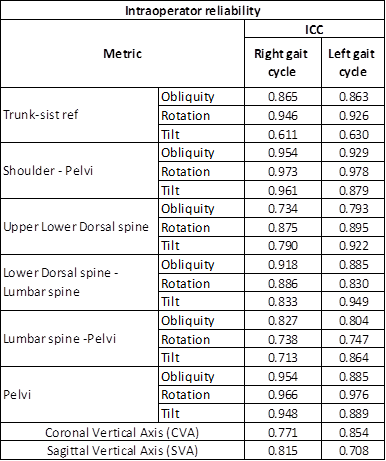Valutazione della cinematica della colonna vertebrale durante il cammino utilizzando sistema optoelettronico: uno studio pilota su persone sane
Assessment of the spine kinematics during walking using the optoelectronics system: a pilot study in healthy people
Introduction
Today spinal disorders in children are very important and widely analyzed with several methods. However, understanding spine kinematics to improve treatment decisions and outcomes is still to be fully exploited [ 1 ]. Stereo-photogrammetric motion analysis in static and dynamic tasks is the gold standard method to assess the real functional limitation [ 2 ]. The functional evaluation of the spine during gait is a growing research area, besides no standard protocols have been developed [ 3 ]. The aim of this study is to analyze the reliability of a new multifactorial analysis protocol of movement to assess the kinematics of spine and its segments (lumbar spine, lower dorsal spine, upper dorsal spine) during gait, on the three anatomical planes, in terms of intra and inter operator variability.
Methods
Healthy subjects, without a history of low back pain or spine related pathology and with age greater than 5 years were admitted to the study. The acquisition procedure use the Smart DX (BTS Bioengineering), and consisted in :
- positioning the markers (30) on the selected body landmarks,
- acquisition of Standing trial: the subject maintains the standing position for at least 5 seconds,
- acquisition of 5 Walking trials: for every trial the subject walks at his preferred speed, for 5 meters.
Every subject repeated 2 sessions with 2 different operators (20 walking trials for every subject). The data collected were elaborated to calculate the ROM of different spine segments, normalized on gait cycle. The interclass correlation coefficient (ICC) (two-way mixed effects model, absolute agreement, average measurements) was calculated, to assess the intra and inter reliability of the protocol.
Results
We assessed 4 healthy subjects: their age was 7.8 yrs, 26.1 yrs, 5.5 and 33.1 yrs (2 males and 3 females).We were able to quantify the spine angles in all the trials acquired. The normal distribution of data was confirmed (Shapiro-Wilk test p>0.5). The ICC values of the ROM of different spine segments assessed, about intra operator and inter operator reliability, are showed in the figure 1 and figure 2. The ICC value 0.5 and 0.75 indicate moderate reliability, values between 0.75 and 0.9, indicate good reliability, and values greater than, 0.90 indicate excellent reliability [ 4 ].
Discussion and Conclusion
We were able to quantify spine angles in healthy subjects in 100% of the acquisitions. The preliminary data confirm that the protocol is reliable in term of intra and inter variability, indeed show good to excellent validation in most of the calculated angles. Further research with a large sample is required and ongoing to confirm these preliminary results. This study was supported by “5 per mille” funds for biomedical research, in particular for the project “5×1000/2023 – Sviluppo di nuovi protocolli di valutazione funzionale multifattoriale e relativi indici per l’età pediatrica” awarded to Prof. Giuseppe Andreoni.
REFERENCES
[ 1 ] R. Haddas, K. L. Ju, T. Belanger, and I. H. Lieberman, “The use of gait analysis in the assessment of patients afflicted with spinal disorders,” Eur. Spine J., vol. 27, no. 8, pp. 1712–1723, 2018, doi: 10.1007/s00586-018-5569-1.
[ 2 ] A. Leardini, F. Biagi, C. Belvedere, and M. G. Benedetti, “Quantitative comparison of current models for trunk motion in human movement analysis,” Clin. Biomech., vol. 24, no. 7, pp. 542–550, 2009, doi: 10.1016/j.clinbiomech.2009.05.005.
[ 3 ] S. Negrini et al., “Trunk motion analysis: A systematic review from a clinical and methodological perspective,” Eur. J. Phys. Rehabil. Med., vol. 52, no. 4, pp. 583–592, 2016.
[ 4 ] T. K. Koo and M. Y. Li, “A Guideline of Selecting and Reporting Intraclass Correlation Coefficients for Reliability Research,” J. Chiropr. Med., vol. 15, no. 2, pp. 155–163, Jun. 2016, doi: 10.1016/j.jcm.2016.02.012.


